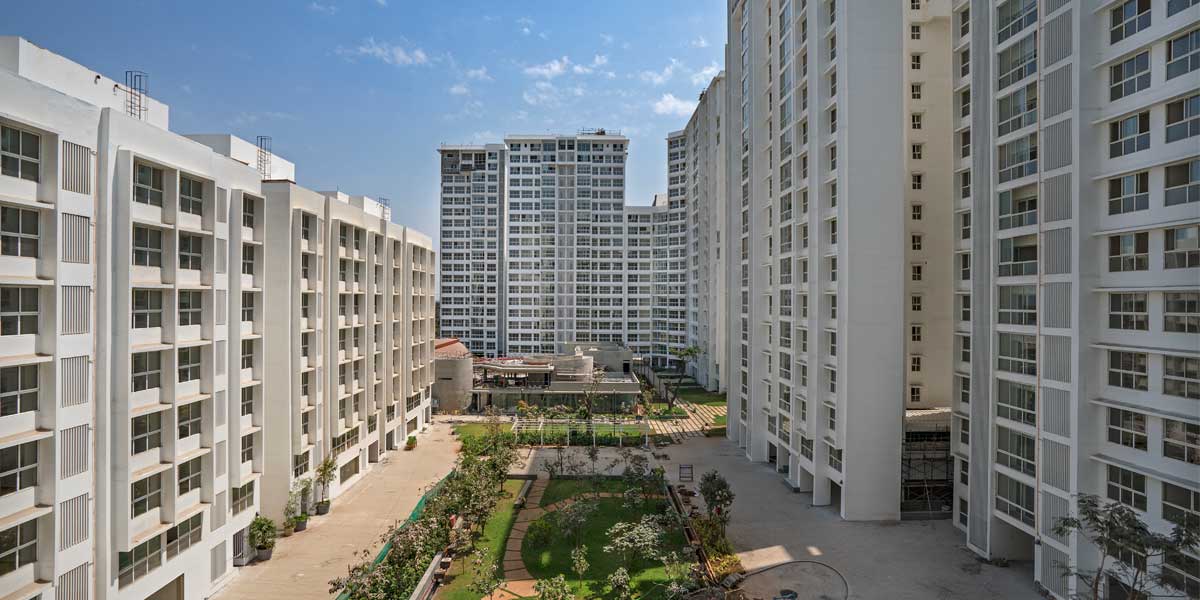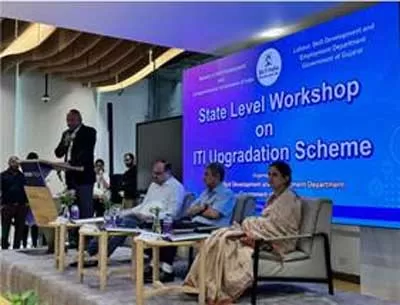Let’s rewind to the months before the pandemic.
A market assessment by Liases Foras showed that half of the unit real-estate supply across 60
cities posed a high to very high risk because developers were not constructing in keeping with
committed timelines. About half of these risky projects were located in the Mumbai Metropolitan
Region (MMR) and the National Capital Region (NCR); the latter simply had too many projects
vis-à-vis demand. About 140 projects had been shortlisted as stuck. And ANAROCK Research
tells us that 1,322 projects and 576,000 units were stuck in December 2019.
We are all too aware of the lull that engulfed the country when COVID-19 struck. But by
September 2020, 60-70 per cent of projects where the builder had sustainable cash flow had
resumed, according to Pankaj Kapoor, Founder and Managing Director, Liases Foras.
Consequently, “nearly 266,000 units were completed during 2020 in the top eight cities,”
reckons Ankita Sood , Director, Research, Growth and Marketing, Elara Group. “Of these,
46 per cent fell in the 2BHK configuration, and 25 per cent each in the 1BHK and 3BHK
categories. Nearly 61 per cent of these units were priced under Rs 45 lakh.”
So, come December 2020, the position was somewhat better than the previous year. But the real-
estate sector was still far from shrugging off the burden of stuck projects. About 300,000 units in
800 projects across the top eight cities were still stuck, estimates Sood. Again, Delhi-NCR and
Mumbai were the largest contributors to the pool.
ANAROCK Research’s higher estimates tell us that 1,132 projects launched in 2013 or before,
accounting for approximately 502,000 units valued at more than Rs 4,07,000 crore, were stuck in
various stages of (non) completion across India’s top seven cities (MMR, Bengaluru, Pune,
NCR, Hyderabad, Chennai and Kolkata). Roughly 180,000 of these stuck/delayed units worth
over Rs 202,145 crore were in the MMR.
December
2019
December
2020
Stuck
projects in India’s top 7 cities
1,322
1,132
Stuck
units in India’s top 7 cities
576,000
502,000
Source: ANAROCK Research
Why, stuck?
So, why were so many projects stuck?
It’s easy to blame it on market fluctuations, but as Ram Raheja, Director, S Raheja Realty,
points out, “Market fluctuations affect projects but not so much that projects would get stuck.”
Another way to answer that question is to examine why some developers have no stuck projects.
“We have never been stuck with anything,” says Raheja. “We don’t overleverage and we don’t
get into projects with technical issues, where someone wants to get something from the land in
question, which usually happens if a developer has overlooked a reservation or got approval for a
plan that shouldn’t have been passed.”
The challenge is that developers get into projects with 10-20 per cent of the budget, thinking
‘sales will get me funds’; of course, then you will get stuck, continues Raheja. “We ensure we
have achieved financial closure.”
“We remain committed to 20 projects with over 10 million sq ft, across 15 cities, across
residential, office and serviced apartments,” says Sanjay Dutt, MD & CEO, Tata Realty and
Infrastructure.
“We follow strict construction timelines, transparent policies and customer-centric approaches to
ensure all our projects are on track and delivered on time,” shares Rajendra Joshi, CEO –
Residential, Brigade Enterprises.
Moving stuck projects
Among the factors that helped getting stuck projects going again, Prashant Thakur, Director &
Head – Research, ANAROCK Property Consultants, cites the Government’s creation of the
Alternate Investment Fund in late 2019 with a corpus of Rs 25,000 crore. “This last-mile
capitalisation mechanism couched in the Special Window for Affordable & Mid-Income
Housing (SWAMIH) fund aimed to alleviate the liquidity crunch that had thrown up roadblocks
for developers. And it has proven to be at least marginally effective. Other government and
RBI’s liquidity-generation initiatives in 2020 also helped.”
“The real-estate specific stress fund (SWAMIH) has been a good step in helping the completion
of stuck projects,” agrees Sood. “Loan recasting at the project level (as suggested by the KV
Kamath Committee) also helped cushion the cash-strapped supply side.”
Demand-side interventions
As so many developers were cash-strapped, a couple of proactive state governments chipped in
to boost demand and restore cash flows.
For instance, Maharashtra reduced stamp duties from 5 per cent to 2-3 per cent in August 2020
through to March 2021. Karnataka, another state making a major contribution to the housing
market, experimented with a similar cut.
Voila!
Sales rose by 200 per cent in Q3 compared to the previous year, observes Siddhart Goel, Senior
Director - Research, Colliers International India, citing the Maharashtra government’s
website.
In particular, Mumbai and Pune saw nearly 1.5 times more sales in Q3 compared to Q2 CY2020,
as per PropTiger Research. In Q4, Mumbai and Pune saw 148 per cent and 62 per cent growth in
sales compared to the previous quarter.
“Property registrations in Mumbai grew three times in December 2020 as against December
2019; Maharashtra showed good growth especially in the primary market, largely owing to
stamp duty relaxations,” says Kapoor.
Vimalendra Singh, Chief Sales Officer, Mahindra Lifespaces, believes the timebound stamp
duty reduction in Maharashtra encouraged fence-sitters in the first two quarters to proceed with
their purchases.
“Certainly, the stamp duty cut was very favourable; we are in the luxury space where a saving of
4 per cent on a Rs 10 crore flat translates into Rs 40 lakh, which is a lot of money,” says Raheja.
“We have had almost Rs 100 crore in sales so far this year with about 10-15 per cent of our sales
going to NRIs.”
However, Sood points out that this uptick in sales must also be attributed to the festive season,
low interest rates, developer schemes and pent-up demand.
“We saw a positive uptick in sales and enquiries since July 2020 and also experienced a good
festive season,” shares Singh. In his view, the lockdown also played a role in this revival. “What
emerged very clearly from the lockdown was the renewed importance of home ownership and all
its allied benefits, including shelter and quality of life.”
“Government action to reduce stamp duties and premiums in Maharashtra combined with a
higher intent towards home ownership as a result of the pandemic have helped drive a
turnaround in sentiment towards residential real estate,” agrees Pirojsha Godrej, Executive
Chairman, Godrej Properties. “The real-estate sector has recovered from the initial impact of
the pandemic.”
In Q3 FY21, Godrej Properties witnessed 25 per cent growth in booking value to Rs 1,488 crore
and 51 per cent growth in booking volume to 2.40 million sq ft.
“We are headed towards 250,000 unit sales across Tier 1 cities by the end of FY 21; within this,
NRI sales and the second home market are both up 20-30 per cent (higher in Maharashtra),
shares Dutt. “Residential sales have exceeded the previous financial year’s sales.”
Dark clouds
Backed by government incentives and developer discounts and offers, Thakur expects the
momentum in housing sales to continue in the current quarter.
Goel also expects the sales momentum to continue in Q4 as stamp duty has increased by only 1
per cent till March 31, 2021, before it reverts to pre-pandemic rates. He expects demand to pick
up pace from H2 2021 to slowly grow to pre-pandemic levels in the next couple of years. News
of the vaccine and the gradual pickup of the economy have boosted positive sentiments and are
expected to boost sales.
“Yes, liquidity for residential projects remains tight but we are seeing some interest from private
funds to provide last-mile funding to feasible projects,” he adds.
It’s not all good though.
Kapoor believes that the euphoria in the market because of the recent pickup of sales is
misplaced. The Indian residential realty market has a huge inventory of 13.5 lakh units across 60
census cities, according to Liases Foras. But, revenue is down about 25 per cent from Rs
2,47,000 crore to Rs 1,88,000 crore. And with Rs 700,000 crore in bank loans outstanding, sales
must increase two times for the industry to stay afloat.
The Government is very aware of this need and to this end, builders have been granted the
concessions we elucidated, and a few more in the recent budget—a tax holiday on affordable
housing projects till March 31, 2022, a commendable supply-side stimulus, which combined
with all-time low home loan interest rates and the stamp duty reduction in Maharashtra, is
expected to provide a strong stimulus to affordable housing, as per Singh. Add to this, social
security to construction workers and an extension of capital expenditure in infrastructure, the
latter of which will expand connectivity and push investment in smaller cities, according to
Joshi.
“In that sense, the pandemic has been a blessing in disguise for developers,” continues Kapoor.
But going forward, he expects the tally of stuck projects to increase after two to three months
when activity further resumes and the monitoring of projects under RERA starts in full scale.
The fate of stuck projects depends on the impact of the delay on the margins of each project,
opines Dutt. “If the debt burden from the delay has eroded whatever margins were possible and
there is no incentive for the developer to perform, the defective baby may be left with the PE
or/and banks or/and NBFCs to take a haircut and bring in another developer, or monetise the
under-construction asset, or let homebuyers take over,” he elaborates. “However, if the surplus
suffices to pay for last-mile funding, service all the debt and comply with RERA’s customer
compensation norms, the project may be taken up and completed to the delight of the
homebuyers.”
Sorting out realty
So, is there a way out of this enduring ‘stuck’ challenge?
What would really help boost activity and generate demand for inputs such as steel and cement
are production-linked incentives, according to Kapoor. “Existing incentives such as telling
builders to take care of stamp duty on the part of customers to halve their premium aren’t helpful
as the intended passthrough doesn’t really happen because the real-estate industry has no MRP
(maximum retail price) concept. Builders simply jack up prices and show they are passing on the
benefit. Unless incentives get passed on to customers, the very high inventory levels will not
drop.”
Sood proposes expanding the scope of the SWAMIH fund to provide last-mile funding to other
projects impacted by the pandemic. She would also like the central bank to consider easing the
criteria for loan recast for the real-estate sector to include developers/projects currently left out
from its scope.
Also, GST on cement should be lowered while the input tax credit should be reinstated, believes
Joshi. “Measures to boost the prop-tech sector, in particular, to spur start-ups driving innovation
and technology in real estate would help as well.”
Increasing the limits of exemption for interest on home loans from Rs 200,000 to Rs 500,000 and
reducing capital gains tax from 20 per cent to 10 per cent would help push the market, opines
Kapoor.
For his part, Harshavardhan Neotia, Chairman, Ambuja Neotia Group, proposes hiking the
Rs 2 lakh tax rebate on housing loan interest rates to around Rs 5 lakh to boost housing,
especially affordable and mid-housing; personal tax relief, either through tax rate reductions or
amended tax slabs such as upwardly revised deduction limits under Section 80C; GST waivers
for under-construction homes, even for a limited period; measures like the recent limited-period
stamp duty cut in Maharashtra; more incentives for private-sector investments in affordable
housing which is suffering from a fund crunch and low profit margins despite being designated
an industry; and easing liquidity to help developers keep up the supply pipeline, especially for in-
demand, ready-to-move-in homes.
Giving industry status to the real-estate sector, including secondary housing and holiday homes,
is a long-pending demand that would help developers raise funds at lower costs, he adds.
We were looking forward to industry status for real estate and a single-window clearance
mechanism, agrees Dutt. “One GST, one or no stamp duty regime and reduction in registration
charges across states will make a significant difference to the cost of a project and definitely
encourage homebuyers. Laying emphasis on the implementation of RERA will protect the
interest of all stakeholders.”
The fact is, the cost of governance, compliance, capital and state government delays has made
real estate unviable for many, Dutt continues. To improve developer liquidity, he proposes
reducing the provisioning requirements for loans to real estate, extending the flexibilities offered
to banks to NBFCs, allowing GST input credit for residential and commercial and allowing FDI
in ready-to-move-in residential inventory. He proposes a stimulus to end-consumer demand by
restoring the subvention scheme for real estate, introducing a 3 per cent interest rate subsidy for
buyers of affordable and mid residential units for three years, cutting state stamp duty to 2 per
cent across states, removing capital gain, and allowing the deduction of bank interest from home
rental incomes.
Then, Indian realty will truly be on the road to recovery.
How can construction in India be made easier?
Between 2019 and 2020, India moved up from the 77 th rank (of 190 countries) to the 63rd rank in
the World Bank’s ‘Doing Business’ reports.
Ease of doing business definitely impacts construction activity, says Siddhart Goel, Senior
Director - Research, Colliers International India. “Andhra Pradesh topped the most recent
Central Government ease-of-doing-business ranking followed by Uttar Pradesh and Telangana.
While Karnataka and Maharashtra continue to have the highest number of construction projects,
the top three states in the ease-of-doing-business ranking are witnessing a strong surge in
construction activities.”
Within the doing business criteria, however, is ease in dealing with construction permits. In that,
India jumped from the 52 nd rank in 2019 to the 27 th rank in 2020.
Behind this leap lies considerable work to improve construction permit system processes under
various stages of implementation in states such as Andhra Pradesh, Uttar Pradesh, Telangana and
Haryana, among others. But to improve the overall ranking, every state will need to abide by best
practices, says Ankita Sood , Director, Research, Growth and Marketing, Elara Group. This
includes adopting an integrated online system for building plan approvals, issuance of
completion and occupancy certificates and faster no-objection certificates for construction
permits.
“Single-window clearances, encouraging innovation and the infusion of credit are some industry
expectations,” she adds.
Industry voices spoke of the gains from single-window clearances.
“One-window clearance is all we want,” affirms Ram Raheja, Director, S Raheja Realty.
“Take undertakings but give us approvals fast, because getting approvals from different agencies
involves a lot of effort and these delays cost us.”
Accelerated, single-window approvals for affordable projects would further boost activity in the
value homes segment, opines Vimalendra Singh, Chief Sales Officer, Mahindra Lifespaces.
A positive is that the Central Government is encouraging states to have online portals for the
approval of construction permits, and is envisioning an integrated platform for external and
internal agencies to provide clearances quickly, observes Goel. “The sooner these initiatives are
implemented, the faster and more sustainable will be the growth of real estate.”
New launches in 2020
Data indicates that the top seven cities saw about 586 new project launches comprising
approximately 128,000 units in the calendar year 2020, shares Prashant Thakur, Director &
Head – Research, ANAROCK Property Consultants. “At least 70 per cent of the unit-supply
(new launches) during the year was in the affordable and mid-segments (priced < Rs 80 lakh)
while 21 per cent was in the higher budget range (Rs 80 lakh to Rs 1.5 crore) and 9 per cent was
in the luxury segment (priced > Rs 1.5 crore).”
Affordable housing projects accounted for almost 54 per cent of the overall new supply in 2020,
followed by the mid-segment and then some luxury projects, adds Siddhart Goel, Senior
Director - Research, Colliers International India. “Most of the supply was of 2 BHK units
followed by 3 BHK at the pan-India level.”
Seeing these opportunities at both ends of the spectrum, affordable as well as high-end units, the
Brigade Group launched towers within existing residential developments and new residential
projects in Bengaluru, Chennai, Mysore and Hyderabad, with unit prices ranging between Rs 33
lakh and Rs 2.15 crore. These include Jasper at Brigade El Dorado, Bengaluru, located close to
the upcoming KIADB Aerospace SEZ; Brigade Citadel, Hyderabad, located in a prime locality
(Moti Nagar) and the largest ever residential development in the city; Brigade Sapphire, Mysore,
a gated community known for its connectivity to major IT hubs in the city; and Tranquil at
Brigade Utopia, a 47-acre township offering a gated community lifestyle replete with retail,
commercial and other such facilities.
The Ambuja Neotia Group also sees scope for all sorts of housing. It is developing a mid-scale
project (south Kolkata), townships (Kolkata and Siliguri), studio apartments (Lataguri) and
country homes (Raichak), and will launch luxury projects (Kolkata). It proposes to open a mall
in Patna and build hotels in Kolkata, Sikkim and Patna to be managed by the Taj Group. Its
commercial projects span compact office spaces to meet the growing need for smaller and
flexible work environments and office blocks in Patna.
Commercial property currently accounts for 30 per cent of Tata Realty’s portfolio with
residential making up the rest. Intellion Parks, Intellion Edge and Intellion Square with over 6.3
million sq ft enjoy over 94 per cent occupancy. Tata Realty wants to balance its asset
diversification and increase the share of commercial property to 60-70 per cent of its portfolio, or
45 million sq ft, in the next seven to eight years and list the Tata Office REIT within two years.
These new investments will be in the top cities: NCR, Mumbai, Bengaluru, Pune, Hyderabad and
Chennai. Tata Realty will soon be relaunching a residential project in Mulund and two fresh
projects in Andheri and Chembur.
Mahindra Lifespaces successfully launched an affordable project, Happinest Palghar, and has
project launches lined up in Mumbai and Pune.
S Raheja Realty launched its largest redevelopment project, two towers of 12 residential storeys
plus four storeys of car parking, in Khar Mumbai.
In FY 21, Godrej Properties launched Godrej Royale Woods, Bengaluru; Godrej Green Cove,
Pune; Godrej Retreat, NCR; and The Highlands in Panvel.
Fate of commercial property
Supply in the commercial office sector has fared much better than residential. Colliers estimated
that supply was down by just 6 per cent at 38.1 million sq ft compared to 2019.
Despite ‘work from home’, the office market reached 27 million sq ft absorption, where it is
expected to remain through 2021 until it potentially recovers to 30-35 million sq ft by 2022,
observes Sanjay Dutt, MD & CEO, Tata Realty and Infrastructure. “Warehousing/logistics,
data centres, e-commerce, artificial intelligence and new start-ups and unicorns are likely to
further the momentum.”
Bigger homes gain from the pandemic
Speaking of the impact of the pandemic on new launches, Siddhart Goel, Senior Director -
Research, Colliers International India says, “Developers have come up with innovative
options to cater to buyers’ demand for houses that facilitate work from home and attending
online study classes, adding an extra study room for an office-like environment or an extra room,
even business centres within residential complexes, and planning more independent homes like
villas and row houses.”
“Work from home and office has renewed the significance of, and interest in, larger, spacious
homes,” agrees Sanjay Dutt, MD & CEO, Tata Realty and Infrastructure, citing improved
sentiment in Tata Realty’s spacious projects like Myst in Kasauli, Tritvam in Kochi, Raisina
Residency in Gurgaon, Serein in Mumbai and Avenida in Kolkata. Myst recorded over 345 per
cent increase in revenue and 86 per cent increase in enquiries in FY 21 compared to FY 20.
- CHARU BAHRI























